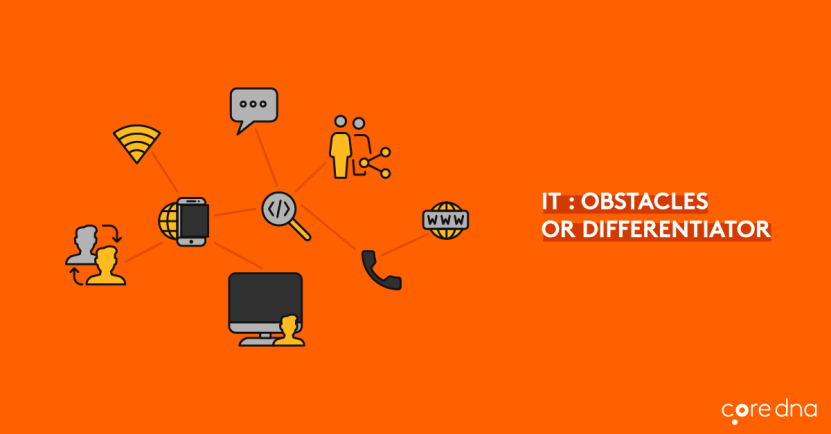Enterprise IT: From Differentiator to Obstacle?

Technology is a commodity. We’ve all heard people say this. In fact, some readers may recall Nicholas Carr’s 2003 article in HBR titled “IT Doesn’t Matter”, which posited exactly that. At the time, it was a controversial opinion.
Today, a whole 15 years later and with digital transformation and disruption two of the hottest topics in business, perhaps it’s a good time to take another look at IT’s role – and relative importance – within the enterprise.
On this page:
Back in my day...
Most of us would agree that many of the business IT challenges from the early naughties, when the world was still nursing a wicked hangover from the dot-com bust, are no longer topics of concern today. Back then, if you were to launch an eCommerce business or even just a halfway decent website, you were in for some real work. Just about everything was a pain-in-the-ass. Not to mention really, really time-consuming and expensive.
Setting up multiple servers, installing and configuring tons of software (quite literally, as much of it still came on CD-ROMs), writing a shit-ton of custom code, configuring firewalls, and on and on. If you wanted content management, you would pay through the nose for commercial software that sucked (anyone remember Interwoven? Or Fatwire?) but was nonetheless really expensive, not only to buy but also to install, configure, customize, and keep running. Open source alternatives were not really a thing yet – though, admittedly, Drupal was around but then again, not really – and wouldn’t be until years later, starting with the 2005 release of WordPress and Joomla!, arguably the first viable options in this space.
License costs were just one part of the equation. Maintaining your infrastructure, including hosting environment, network connectivity, integrations, security, and so forth required a ton of “stuff” and an army of people. Designing, coding, testing, and launching your site was equally painstaking, expensive, and error-prone.

We’ve come a long way, baby
Today, with the rise of cloud computing and SaaS, it seems that just about any service or function one might need is available online, nearly instantly, and for a fraction of the cost it would take to build it yourself. In contrast, back in 2003, you had to build just about everything yourself. Or hire someone to do it for you.
Having all of this functionality available at a moment’s notice has had a profound impact on business. At the software startup where I work we take full advantage of today’s on-demand software-as-a-service offering. We use SaaS products like Basecamp, Drift, GitHub, GMail, Hubspot, MailChimp, Slack, Trello, Wunderlist, and many more.
And, when something better comes along – as happens frequently in this dynamic environment – we will evaluate it and, if it makes sense, switch. Quickly. That, too, is something that is fundamentally different today. Switching platforms can be done relatively quickly provided the business did their homework upfront and ensured that their vendor had the ability – and willingness – to export their data in a clean and standardized format. It’s important to note that this sort of vendor lock-in – while real and not uncommon – is a business issue and an artificial construct that can be addressed in a contract. While there are other barriers to switching solutions they are far lower than previously and quite different than before.
Whereas previously a company may have invested a six or even seven-figure amount in upfront license costs and two or three times that amount (and often far more) in customization and implementation and then had to amortize these costs, SaaS solutions are generally much quicker and cheaper to implement.
This allows companies to be more agile and able to change systems more rapidly should a solution fail to deliver or a better alternative present itself. This flexibility and speed allow companies to react quickly to changes in the market, be it by rolling out a new offering, increasing or reducing system bandwidth and throughput by scaling dynamically, or by launching in new markets.
Similarly, just as the agility provided by cloud solutions is an advantage, so can being wedded to inflexible legacy applications put a company at a disadvantage. Not only do these systems lack the ability to scale to meet bursts of traffic or demand dynamically, they are often also inflexible in their ability to adapt to changes in the marketplace or accommodate new processes or offerings. This can be as simple as supporting new product or service bundles, integrating a new partner or service provider, or as complex as adapting to a new and emerging business model such as a subscription model.
While SaaS systems may not always have an inherent advantage over legacy software in these instances – though arguably they do – their lower upfront investment and quicker implementation does reduce sunk costs and thus vendor lock-in and make it easier to react to market changes by simply switching platforms.
No man is an island
But what about integrations, you say? And indeed, most enterprise systems need to integrate into a landscape of other systems and solutions.
Today’s cloud solutions handle these challenges with relative ease however, thanks to modern APIs and common open data standards. Again, the SaaS model offers certain advantages here, if for no other reason than the fact that they tend to be newer than most legacy platforms.
So, just like a building that was constructed in the last ten years will generally already come pre-fitted for HVAC, data communications, and other modern needs, so will a true SaaS solution generally feature a flexible composite or micro-services architecture, support open APIs and data standards, and often have pre-built, configurable connectors to common ancillary systems that many legacy applications lack. Worse yet, the architecture of the legacy system may be a real impediment to integration and require complex, brittle, and expensive workarounds.

Focus on value creation
It’s common belief that companies should focus on their core business and value creation. The same is true when it comes to IT, a relative newcomer when compared to operations, HR, finance or other departments. Just as companies have moved to outsource other areas, they should also increasingly view software as a commodity and therefore move to outsource those parts that are not core to their business. Failure to do so will have a negative financial impact and may threaten overall competitive position as the business is unable to react to market changes with the speed and agility today’s environment demands.
Instead of tinkering with low-level “utility” systems – things like content management, eCommerce enablement, payment processing, CRM, etc. – companies should focus on what deliver real business impact: optimizing customer experience, creating effective campaigns, crafting engaging content, and building their brand.
Lose the ballast – gain the speed
So, perhaps it’s time to jettison some of the bulky legacy systems slowing your company down? Or, at least, explore leveraging flexible, more agile enterprise cloud solutions for new initiatives in order to get exposure and develop familiarity and expertise.
Chances are, once business users get a taste of what’s possible, there will be no holding them back. I know that when we first begin working with clients switching to our SaaS-based digital experience and eCommerce platform they are often amazed at the pace at which we can roll out new functionality or stand up a new instance. And shorter implementation times also mean less cost and risk.
Which is not to suggest throwing the baby out with the bathwater and ditching all of your enterprise systems. Flexibility is one of the key attributes of SaaS and the cloud, so feel free to go in stages. Crawl, walk, run; all at whatever pace your organization can support and your management is comfortable with. One thing I promise you is this; they will be more than happy with the cost savings and agility that comes as a result.
Who knows, it might even be enough to cover a nice end-of-year bonus for you?













